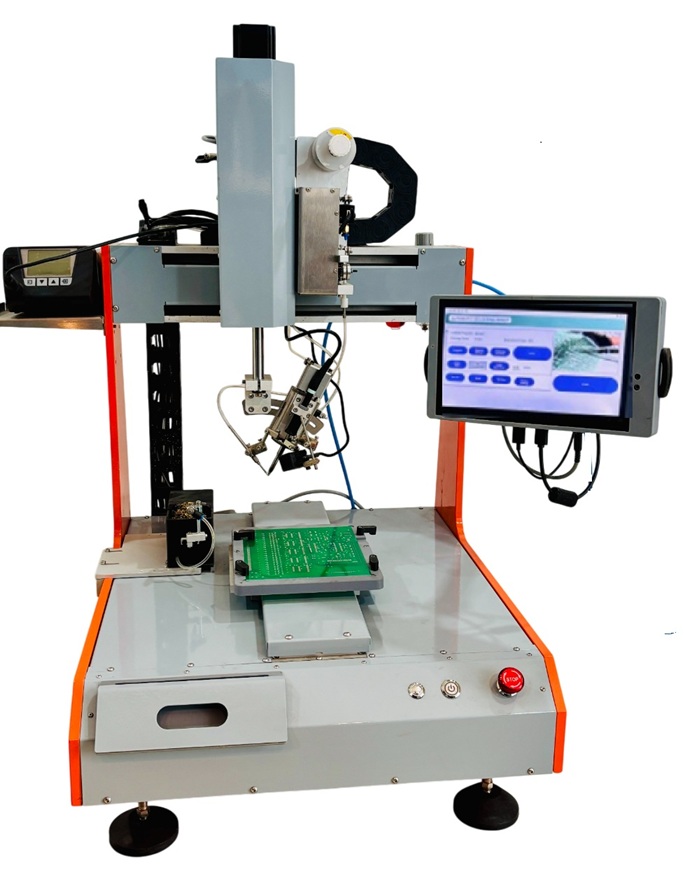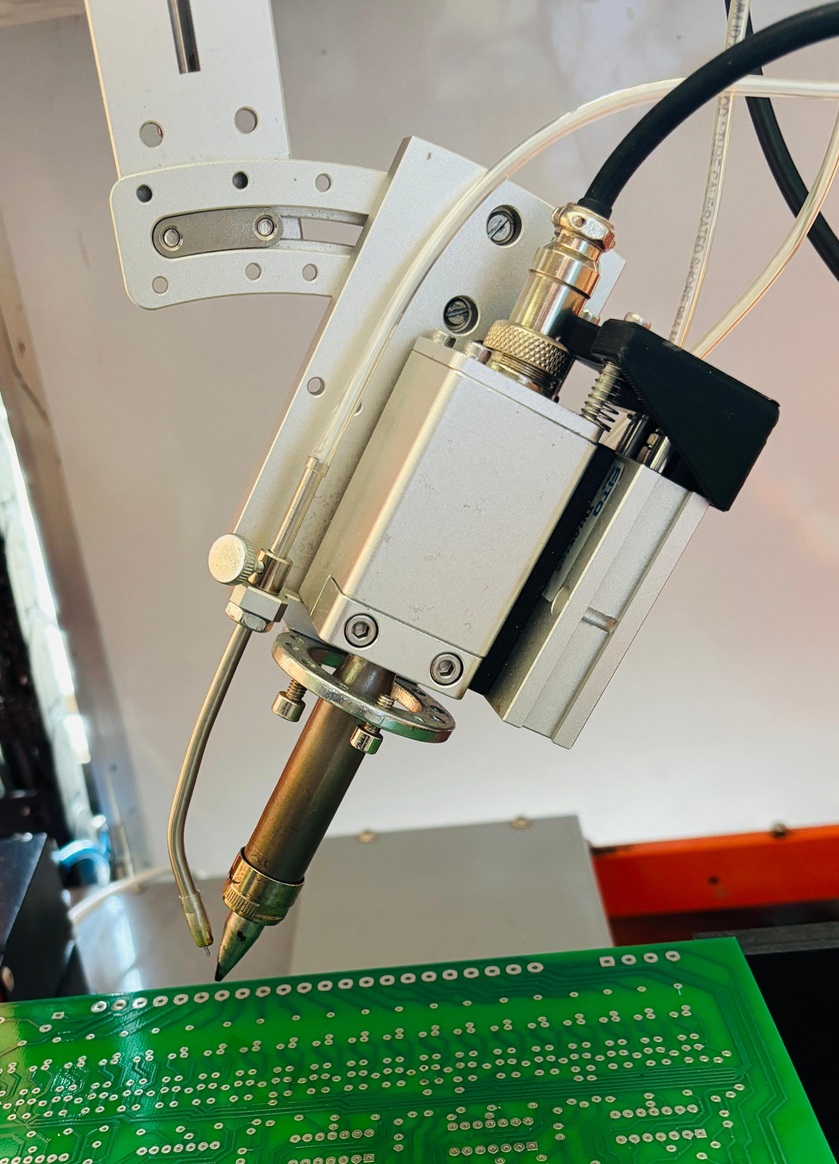Designed By
SlightGen Solutions
Product Description
The Automatic PCB Soldering Robot is an advanced robotic system created to automate the soldering process of electronic components onto PCBs. By integrating precision mechanics, intelligent electronics, and user-friendly software, this system ensures efficiency, accuracy, and repeatability across all soldering operations.
Why Choose Robotic Soldering?
Manual soldering presents challenges such as:
- Human error and fatigue leading to inconsistent solder joints
- Quality variability in large production runs
- High labor cost and dependency
- Safety hazards due to heat and fumes
The Automatic Soldering Robot overcomes these challenges by providing a controlled, repeatable, and intelligent soldering process.
Made in India Advantage
- Comparable to premium brands at a fraction of the cost.
- Superior to low-cost Chinese alternatives, offering long-term stability, better after-sales support, and customization options.
- Fully designed and manufactured in India, aligning with the “Make in India” mission while delivering globally competitive quality.
This robot bridges the gap for SMEs and large manufacturers, offering high-end automation that was previously prohibitively expensive or inaccessible.
Unlike imported alternatives, this robot is fully customizable as per customer requirements. From bed size to soldering station type, dual-head configurations, and integration with existing production lines — the platform can be tailored to match unique production needs.
Soldering Robot Applications:
In modern electronics manufacturing, there are multiple soldering techniques available, including manual soldering, wave soldering, and robotic soldering. While wave soldering is often used for high-volume through-hole assemblies, it has clear limitations that make it unsuitable for many applications:
-
Leaded Components & Heat-Sensitive Parts Wave soldering cannot handle components that require selective soldering or parts that demand controlled heating profiles. Overexposure to wave soldering can damage sensitive components or create bridging issues.
-
Complex PCB Assemblies Designs where two PCBs are connected at right angles (90° joints), or boards with mechanical constraints, are not compatible with wave soldering techniques. These assemblies require precise, targeted soldering that only a robotic system can provide.
-
Wire & Connector Joints Many applications involve soldering wires, terminals, and large connectors directly to PCBs. Such solder joints require point soldering with controlled dwell time and solder feed — tasks that wave soldering cannot perform.
-
Mixed Technology Boards In today’s electronics, it is common to see SMT + through-hole hybrid boards. While SMT components are reflow soldered, the remaining through-hole parts still need reliable soldering. Robots offer the precision and repeatability necessary to meet IPC quality standards.
-
Prototype and Small-Batch Production For low to medium volumes, setting up an entire wave soldering line is impractical and costly. A soldering robot offers the perfect balance between flexibility and efficiency, allowing manufacturers to change programs quickly for new board designs.
Benefits Soldering Robot:
- High precision: Automatic soldering robots are equipped with advanced motion control systems that provide precise positioning and movement, ensuring accurate soldering of components onto PCBs.
- Consistency: By eliminating human error and variability, automatic soldering robots deliver consistent solder joints across a large number of PCBs, resulting in improved product quality and reliability.
- Efficiency: Automatic soldering robots can significantly reduce the time required for soldering operations, enabling high-volume production with increased productivity and reduced labor costs.
- Flexibility: Automatic soldering robots can be programmed to handle various types of PCBs and components, making them suitable for a wide range of electronic assembly applications.
- Safety: Automatic soldering robots are designed with safety features to protect operators from hazards such as high temperatures, fumes, and sharp objects, ensuring a safe working environment.
- Connectivity: Automatic soldering robots can equipped with connectivity features that allow for remote monitoring, programming, and data logging, enabling real-time control and analysis of the soldering process.
Key Highlights:
-
High-Precision 4-Axis System Equipped with industrial-grade mechanics and a 4-axis motion control setup (X, Y, Z, R), the system supports complex soldering paths with exceptional accuracy and repeatability—ideal for both simple and intricate PCB layouts.
-
Made in India Designed and manufactured entirely in India, this robot offers a high-performance, cost-effective alternative to expensive imported machines—empowering local innovation and supporting the Indian electronics manufacturing ecosystem.
-
Intuitive 10-inch Touchscreen Interface An Android/Linux-based display replaces traditional teach pendants, providing a modern, easy-to-use interface for programming, job setup, and machine operation—no prior experience required.
-
Integrated Weller 150W Soldering Station Utilizes the original Weller WT1H station with genuine tips and heating elements to deliver precise and consistent soldering—especially effective for fine-pitch and sensitive components.
-
Auto Temperature Adjustment Each soldering point can have a custom temperature setting, automatically managed by intelligent software for enhanced joint quality and reduced thermal stress. (Feature available only with Weller integration.)
-
Automatic Tip Cleaning A built-in air-blast system periodically cleans the solder tip, ensuring optimal performance, reducing manual maintenance, and extending tip life.
-
Pneumatic Tip Movement The vertical movement of the soldering tip is controlled via pneumatic actuation, allowing faster response, reduced cycle time, and more stable operation during repetitive soldering tasks.
-
On-Tip Camera Integration A 5MP camera mounted directly on the soldering head offers a real-time video feed, improving alignment, monitoring, and soldering accuracy—especially useful for small-pitch components.
-
Joystick-Based Navigation Programming solder points is simplified using a joystick, eliminating the need for difficult-to-operate teach pendants. This makes setup faster, easier, and more accessible even for new operators.
-
Solder Wire Jam & Run-Out Detection Smart sensors detect when solder wire is depleted or jammed, automatically pausing operation to prevent missed joints or overheating. Once reloaded, the machine resumes from the last point, minimizing disruption.
-
Ball Screw Drive System The Z-axis is driven by a precision ball screw mechanism, offering smoother motion, higher load capacity, and excellent durability compared to conventional belt-driven setups.
-
V-Groove Solder Feeder The specialized solder feeding mechanism includes a V-groove cutter that reduces flux splatter by managing gas pressure, resulting in cleaner and safer solder joints.
-
Remote Access and Support Supports remote connection through apps like TeamViewer or AnyDesk, enabling diagnostics, updates, and technical support from anywhere without needing on-site intervention.
-
Local Service & Support We provide reliable after-sales service, training, and customization through our skilled Indian engineering team—ensuring smooth deployment and long-term support for your production line.
-
Customizable Configurations Depending on customer requirements, the machine can be customized with larger or smaller bed sizes, dual-head systems for parallel soldering, or dual-bed setups to maximize throughput—making it adaptable to a wide range of applications and production scales.
Customization Options
One of the biggest advantages of our Automatic PCB Soldering Robot is its ability to be customized as per customer requirements. Unlike imported systems that are fixed in design, our platform is flexible and adaptable to meet diverse production needs.
Available Customizations
-
Dual-Bed System Supports two working beds for increased throughput. While one bed is soldering, the other can be prepared, reducing idle time and improving productivity.
-
Interchangeable Soldering Stations & Tips The machine can be desinged with different soldering stations such Bakon 180S, or even 200W+ high-power stations. Customers can choose tips based on their applications — from fine-pitch tips to heavy-duty connectors.
-
Dual-Head System Two soldering heads can be integrated to solder multiple points simultaneously or handle different soldering profiles in the same job, doubling efficiency.
-
Custom Bed Sizes The robot can be manufactured with larger or smaller bed sizes depending on PCB dimensions and production requirements.
-
X/Y/Z Ball/Belt Screw Drive Option to replace standard belt-driven X and Y axes with ball screw mechanisms for ultra-precise positioning and repeat accuracy.
-
Servo or Closed-Loop Stepper Motors Customers can choose servo motors or closed-loop / 5 phase stepper motors instead of open-loop stepper motors, enabling higher precision, smoother motion control, and improved reliability for demanding soldering tasks
Future-Ready Platform
The Automatic PCB Soldering Robot has been engineered as a scalable and upgradeable platform, ensuring that customers investing today will be able to benefit from advanced features in future versions. While the current release already delivers high-precision soldering automation, additional features are under development to further enhance productivity and quality assurance.
Planned Upgrades
-
AOI (Automated Optical Inspection) Integration of AOI will allow each PCB to be automatically verified after soldering using image processing algorithms. This ensures consistent solder joint quality, detects defects instantly, and reduces the need for manual inspection.
-
Direct Gerber/Drill File Import Instead of manually teaching solder points, the system will support direct import of Gerber and drill files. This will drastically reduce job setup time and allow engineers to generate soldering programs directly from PCB design files.
-
Optimized Solder Feeder Positioning A redesigned feeder system will position the solder wire feeder closer to the soldering iron tip, ensuring smoother and more accurate wire delivery. This reduces feeding errors, minimizes solder waste, and improves overall solder joint quality.
Working
The automatic PCB soldering robot is divided into three main components:
- Mechanical System:
- The machine is built on a 4-axis robotic platform, consisting of an X-Y gantry, a Z-axis for vertical movement, and an R-axis for rotational movement (manual/automatic).
- Motion is achieved using a belt and ball screw mechanism combined with high-quality stepper motors, ensuring precision and smooth operation.
- The soldering head is equipped with a Weller soldering station, mounted on a pneumatically controlled mechanism that enables quick, stable, and accurate vertical (up-and-down) movements.
- An air-pressured soldering tip unit maintains stable soldering performance and efficient heat transfer.
- A solder wire feeder unit delivers solder wire directly to the tip. It is integrated with a run-out detection sensor that identifies when solder wire is depleted during operation, preventing incomplete joints and process interruptions.
- Electronics System:
- The electronics architecture includes stepper motor drivers, a motion controller, sensors, power supply modules, and controller firmware.
- Motion control is powered by a 32-bit ARM controller, providing high-speed and accurate motion coordination.
- High-quality stepper motor drivers ensure smooth, reliable performance and precise movement control.
- A custom-designed firmware manages all operations, including motion planning, soldering process control, and real-time sensor integration.
- Software System:
- The robot is equipped with an Android/Linux-based LCD module running a*custom-designed application that provides a simple and intuitive interface for programming and operating the soldering robot.
- Operators can define soldering points, configure process parameters, and execute preloaded soldering programs directly from the touchscreen interface.
Product Specifications
| Feature | Specification |
|---|---|
| Voltage | 200–230 VAC |
| Axes | 4-Axis (X, Y, Z, R) – options: dual-head, dual-bed, or customized |
| Soldering Station | Weller 150W (WT1H) / (Options: Other barand) |
| Operating Modes | Manual (Jog/Position, Speed, Coordinates, Control Commands) / Auto (Program mode) |
| Programs | 1000+ |
| Soldering Type | Point Soldering, Drag Soldering |
| Bed Size | X: 300 mm, Y: 300 mm, Z: 120 mm, R: 300° (Customizable size) |
| Max Speed | X/Y: 500 mm/s, Z: 300 mm/s, R: 100°/s |
| Accuracy | ±0.02 mm / degree |
| Drive System | 2-phase open-loop stepper (options: closed-loop / 5-phase) |
| Weight | ~60 kg |
| Teaching Methods | Joystick teaching, LCD offline teaching, numeric entry |
| Interfaces | 10" Touch LCD , 2 × USB 2.0 |
| Camera | 5 MP solder head camera |
| Tip Cleaning | Pneumatic air-blast system |
Product Datasheet
🔗 Datasheet
Product Photos
Product Videos
Soldering Multiple points on PCB
Full Working
Drag Soldering


